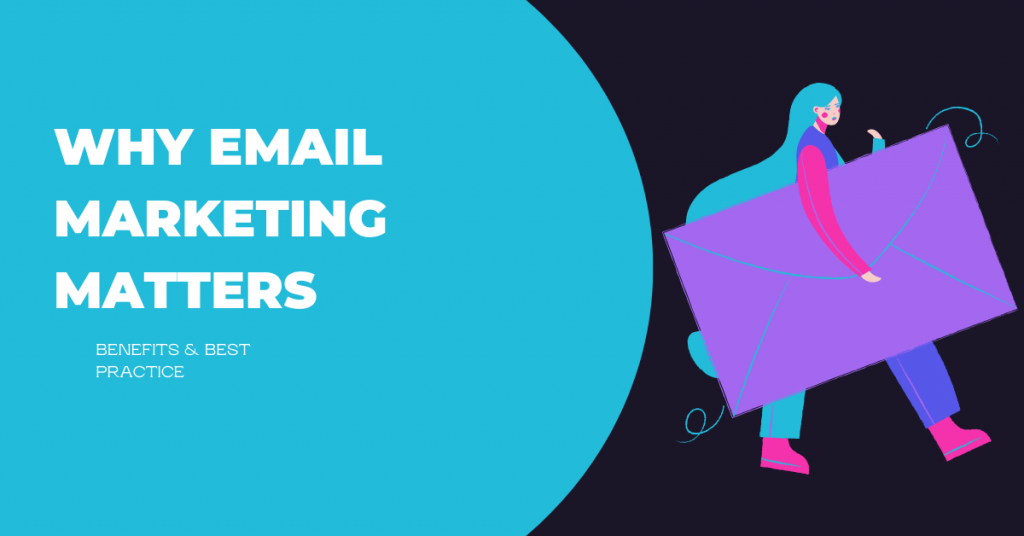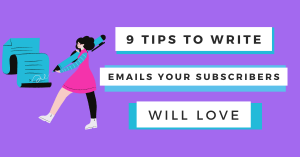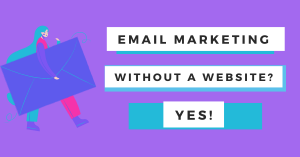- Benefits of Email Marketing
- How to Create an Effective Email Campaign
- Tips for Writing Engaging Emails
- 4 Types of Email Campaigns You Can Send
- 5 Best Practices for Email Marketing Success: Segment Your List, Set Goals and Measure Performance, Leverage Automation, Monitor Your Reputation
- FAQs: “Why Email Marketing Matters”
- Delegate your email marketing and watch your revenue soar
Email marketing matters, and it’s something that every small business owner or service provider should pay attention to.
If you want your message to reach the right people at the right time, email is still one of the best ways to do it. In this blog post I’ll discuss why email marketing matters and share tips on how you can create an effective campaign for maximum impact.
I”ll cover everything from setting goals and measuring performance, leveraging automation tools, writing engaging emails with key takeaways in mind – all without sacrificing quality!
So if you’re ready to learn more about why email marketing matters then read on – there are plenty of great strategies waiting for you!
Benefits of Email Marketing
It allows you to reach a large audience quickly, promote your brand, and increase sales. Here are some of the key benefits of email marketing:
Increased Reach: Email marketing can help you reach more people than traditional methods like print or television advertising.
With email, you can target specific audiences with tailored messages that are sure to grab their attention.
Plus, it’s easy to track who opens your emails so you know exactly how successful your campaigns have been.
Cost-Effective: Email marketing is one of the most cost-effective ways to market your business or services. On average, you can get $36 back for every $1 you invest in email marketing!

Once people are on your list, it costs you nothing to send an email.
This makes it much easier on the budget compared to other forms of advertising such as radio or TV ads which require expensive equipment and airtime fees.
Improved Brand Awareness: By regularly sending out emails about new products, promotions, events, etc., customers will become familiar with your brand name over time—increasing customer loyalty in the process!
Additionally, if someone shares one of your emails with friends or family members they may become interested in what you have to offer too!
Automation and personalization can be used together to save time while still providing customers with relevant information at the right moment.
For example, automated welcome emails can be sent out whenever someone signs up for a newsletter list, while personalized follow-up messages could be used after a purchase has been made from an online store.
Both tasks require little effort but make customers feel valued by providing them with the information they need.
Email marketing is a powerful tool for small businesses and solopreneurs, offering numerous benefits that can help to increase reach, save money, boost brand awareness and improve customer engagement. Now let’s look at the best practices of email marketing.
Key Takeaway: Email marketing is a powerful tool for small businesses and solopreneurs to reach their target audience quickly, promote their brand, and increase sales. It’s cost-effective, increases reach, boosts brand awareness, and can be automated or personalized for maximum impact. By taking advantage of the benefits of email marketing you can ensure that your business reaches its full potential.
How to Create an Effective Email Campaign
Creating an effective email campaign requires careful planning and execution. Identifying your target audience is the first step in creating a successful email campaign.
Knowing who you are targeting will help you craft a compelling subject line that resonates with them and encourages them to open your emails.
Once you have identified your target audience, it’s time to write engaging content for your emails. Keep it short and sweet while using actionable language, humor when appropriate, and personalization techniques such as addressing readers by name or mentioning their interests.
Remember to use call-to-action phrases that link directly to desired pages on your website or landing page.
Testing, tracking, and analyzing results are essential components of any successful email marketing strategy.
Test different versions of subject lines or offers to see which ones get more opens or clicks from subscribers; track how many people opened each version; analyze data from past campaigns; use A/B testing for further optimization; then make adjustments based on what works best for each segment of subscribers on your list.
Additionally, optimizing for mobile devices should not be overlooked since most people now access their emails through smartphones rather than desktop computers.
By following these steps when crafting an effective email campaign, small business owners can ensure they reach their goals while building relationships with customers along the way.
These steps include identifying target audiences, writing engaging content with visuals and CTA buttons included, testing and tracking results, and optimizing for mobile devices.
With the right approach, email campaigns can be an effective way to reach your target audience and increase engagement. Now let’s look at how to measure success and track results for these campaigns.
Key Takeaway: Successful email campaigns require careful planning and execution. To ensure a successful campaign, small business owners should: 1. Identify target audiences 2. Write engaging content with visuals and CTA buttons included 3. Test, track, and analyze results 4. Optimize for mobile devices By following these steps when crafting an effective email campaign, small business owners can reach their goals while building relationships with customers along the way.
Tips for Writing Engaging Emails
Writing engaging emails is essential for successful email campaigns. Keeping your messages short and sweet will help ensure that readers don’t get overwhelmed or bored with too much text. But don’t be afraid to test longer messages.
Focus on the key points you want to communicate, and be sure to include a call to action at the end of each message.
Using humor when appropriate can also make your emails more interesting and memorable. Humor helps break up long blocks of text, lightens the mood, and encourages people to read further.
Just be sure that any jokes you use are relevant to your topic and audience so they don’t come across as forced or out of place.
Personalizing messages is another great way to engage readers in an email campaign. Use their first name in the subject line or body of the message, address them directly throughout the content, and tailor it based on their interests or previous interactions with your brand if possible.

This will show them that you value their time by providing information specifically tailored for them instead of sending generic mass emails every time.
Using actionable language is essential for quickly and effectively engaging readers with your content.
Keep sentences concise yet descriptive so they can understand precisely what you want them to do after reading each sentence, such as clicking a link, downloading something, or signing up for a service.
Make sure all calls to action are visible within each message and easy enough for anyone who reads it to comprehend how they should proceed without confusion or hesitation.
Writing engaging emails is an important part of any successful email marketing strategy. To ensure your messages are well-received, focus on crafting concise and personalized content with a touch of humor when appropriate. Now let’s explore ways to make sure your emails get opened and read!
Key Takeaway: Email marketing is an effective way to reach potential customers, but it’s important to keep messages engaging and personalized. Use humor when appropriate, personalize each message for the reader, and use actionable language with clear calls-to-action. Doing so will help ensure that your emails are memorable and successful.
4 Types of Email Campaigns You Can Send
Welcome emails are a great way to introduce yourself and your business to new customers.
They can include an introduction, information about the company, a special offer or discount code, and links to helpful resources. Welcome emails also help build trust with potential customers by providing them with useful information right away.
Newsletters are another type of email campaign that businesses use to keep their customers informed about news, updates, and promotions. But they’re also useful to share stories and tidbits of value.
While you’ll see advice about keeping newsletters infrequent, I always tell my clients to send newsletters as often as possible — between three times a week to once per day is the sweet spot.
Promotional emails are used by businesses to promote products or services they offer (duh). These types of campaigns often include discounts or coupons for certain items as well as images of the products being promoted along with descriptions and pricing details.
You can combine promo emails and newsletter emails if you’ve always got something to offer. For example, I format my and my clients’ email newsletters as follows:
- Opening line to hook the reader’s attention
- Story or valuable nugget of information
- Quick segue into why that matters for the audience
- Short call to action with an offer
Abandoned cart emails serve to remind shoppers who have left items in their shopping carts without completing their purchase why they were interested in those items initially.
They’re useful for ecommerce businesses, but can be great for service providers and solo business owners who sell digital products, too.
Additionally, incentives such as free shipping or a discount code are offered if the order is completed within a certain time frame.
This type of email campaign helps increase conversions by encouraging people who may have forgotten about their original intentions but still desire what was placed into their cart.
With the right combination of email campaigns, you can build relationships with your customers and increase conversions. Let’s look at how to create an effective email marketing strategy.
Key Takeaway: Email marketing is an important tool for businesses to reach out to customers and increase conversions. Welcome emails introduce the company, newsletters keep customers informed about news and promotions, promotional emails advertise products or services, and abandoned cart emails remind shoppers of their original intentions. All of these types of campaigns should be designed in a way that encourages readers to take action on the content provided within them.
5 Best Practices for Email Marketing Success: Segment Your List, Set Goals and Measure Performance, Leverage Automation, Monitor Your Reputation
To get the most out of email marketing, it’s important to understand best practices that will help you succeed.
Segment Your List: By segmenting your list into different categories such as location, interests, or purchase history, you can target specific groups of people with tailored messages that are more likely to resonate with them.
This increases the likelihood of engagement and conversion from those contacts.
Set Goals and Measure Performance: Establish goals for each campaign before sending emails so that you have something tangible to measure against once the campaign has been sent out.
Track open rates, click-through rates (CTR), unsubscribes, bounces etc., in order to gain insights on how successful your campaigns were in reaching their intended audience and achieving desired results.
Leverage Automation: Automating certain aspects of email marketing helps save time while still delivering relevant content when needed.
You can set up automated welcome emails when someone subscribes or abandoned cart reminders if they leave items in their shopping cart without completing the checkout process etc., which helps keep customers engaged even when there’s no one actively managing campaigns at all times.
By implementing these best practices for email marketing success, you can ensure your campaigns are successful and reach the right people. Next, I”ll discuss how to craft compelling emails that engage your audience.
Key Takeaway: Email marketing is an effective tool for small businesses and solopreneurs to reach more customers, build relationships with them, and increase brand awareness. To get the most out of it, segment your list into different categories, set goals and measure performance, and leverage automation.
FAQs: “Why Email Marketing Matters”
Is email marketing still important in 2022?
Yes, email marketing will still be important in 2022 (and 2023).
Email is a powerful tool for connecting with customers and prospects, building relationships, and driving sales.
It allows businesses to reach their target audience quickly and efficiently while providing personalized content tailored to individual needs.
Additionally, email campaigns can be automated to save time and resources for small business owners who are often strapped for both. In short, email marketing remains an essential part of any successful digital marketing strategy in 2022.
What are the benefits impact of email marketing?
Email marketing is an effective way to reach and engage with customers. It allows businesses to nurture relationships, build trust, and increase brand awareness. By sending personalized messages that are tailored to the interests of each customer, businesses can create a more personal connection with their audience.
Additionally, email marketing helps boost sales by providing customers with discounts or special offers that encourage them to make purchases. Finally, it’s cost-effective since it requires minimal resources compared to other forms of advertising. Email marketing is an essential tool for any business looking to maximize its potential and grow its customer base.
Delegate your email marketing and watch your revenue soar
Now you know why marketing matters — it’s a powerful tool for small businesses and solopreneurs to reach their target audience, build relationships with customers, and increase sales. With the right strategy in place, you can create effective email campaigns that will engage your subscribers and drive results.
By segmenting your list, setting goals and measuring performance, leveraging automation, monitoring your reputation, and following best practices for success – you’ll be able to maximize the impact of your email marketing efforts. So don’t forget: Email Marketing Matters!
But if you’re feeling overwhelmed at adding yet another task to your never-ending to-do list, I’ve got your back. My team and I strategize and implement nurturing and high-converting email sequences that sound exactly like you. Book a call with me today to go over your custom email strategy!







